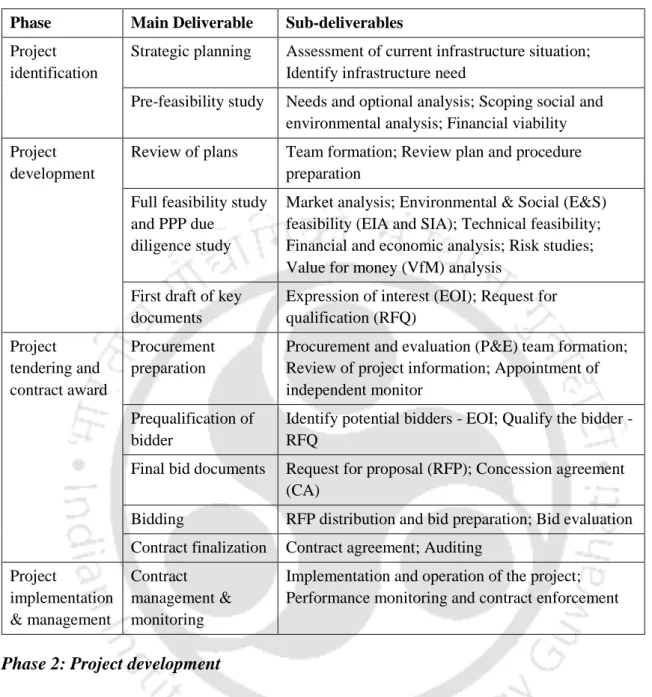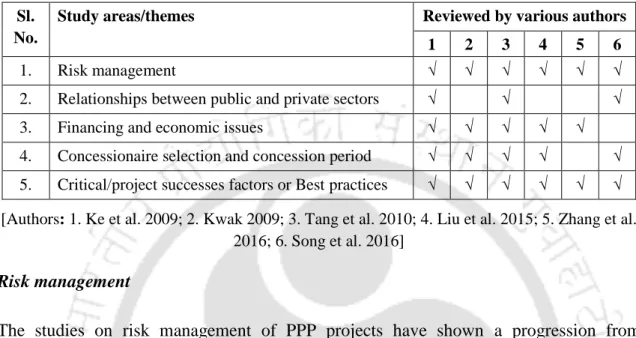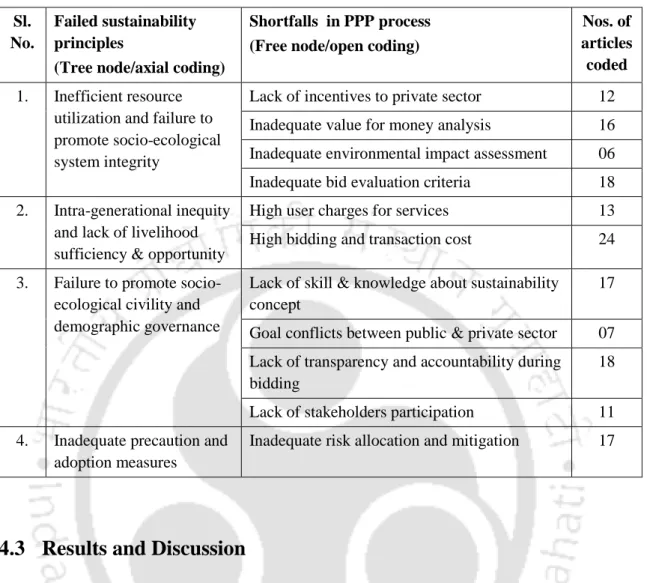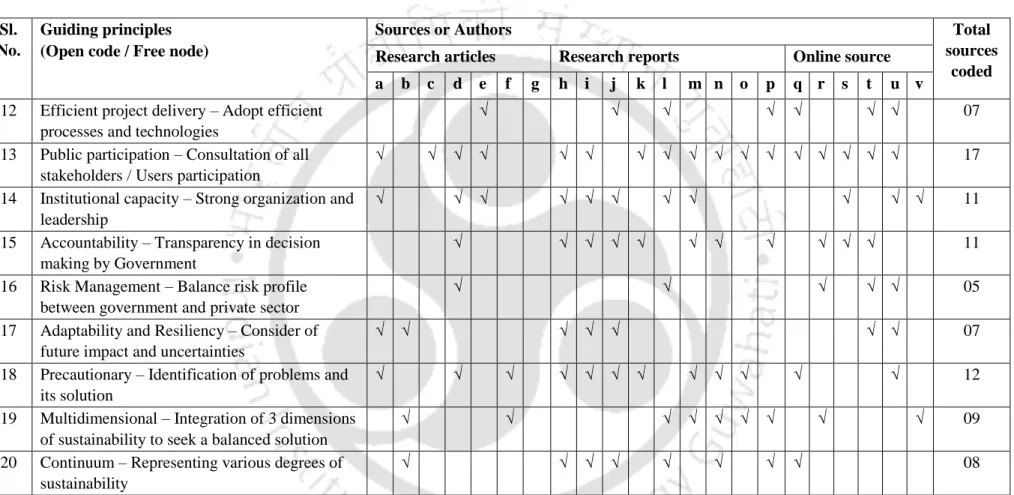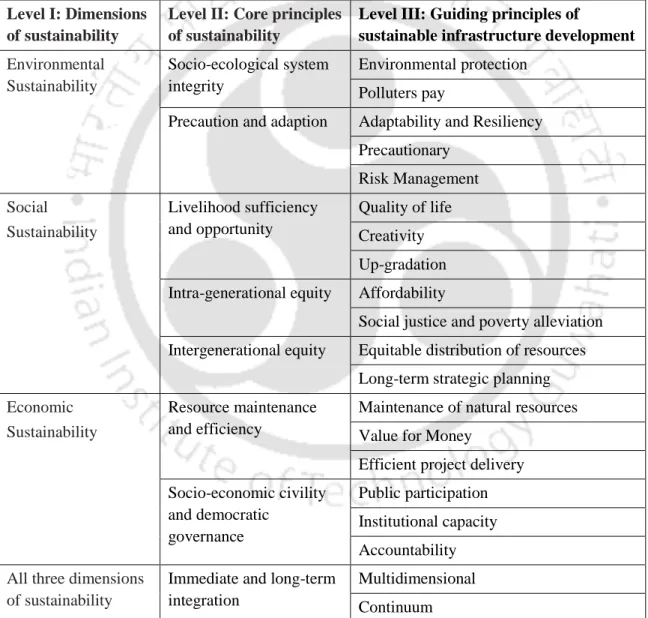Laishram Boeing Singh (Research Supervisor) Associate Professor Department of Civil Engineering Indian Institute of Technology Guwahati. UNCED United Nations Conference on Environment and Development UNCSD United Nations Commission on Sustainable Development UNDES United Nations Department of Economic and Social Affairs UNDP United Nations Development Programme.
Background and Need for the Study
Incorporating sustainability principles into the procurement of infrastructure projects through PPP mode can lead to the development of better infrastructure, bring more benefits to the better society and improve the quality of the environment (Samuel and Oshani 2011). Under the 12th Five Year Plan, the proposed investment in infrastructure has been estimated to be around US$1 trillion with a plan to attract half of the required private sector investment through the PPP route (Planning Commission 2013b).
Problem Statement and Research Question
Given the importance of different aspects of PPP and focus on performance measurement from a sustainable development perspective, it is of great importance for policy makers to adapt the PPP procurement process from a sustainability perspective. Therefore, the present study aims to collect evidence to answer the following research question: How to improve the PPP procurement process using the concept of sustainable development.
Research Aim and Objectives
Contributions from the Research
The ultimate goal of conducting this study is to improve current PPP procurement practices for infrastructure development in order to contribute to sustainable development goals. It is expected that improving the procurement process of PPPs will increase the applicability of PPPs in less profitable regions (such as the Northeast region of India) and other social infrastructure sectors such as water and wastewater.
Research Methodology
In phase 5, the final framework was validated against six validation aspects through an e-mail survey with the same experts who participated in the targeted interviews.
Organization of the Thesis
It includes a summary of the study, important research findings, implications of the research, limitations for the current study and scope for future research.
Introduction
Public Private Partnerships for Infrastructure Development
- PPPs in general
- PPPs in India
- PPP procurement process in India
- Past research’s on PPPs for infrastructure development
Design-Build-Finance-Operate (DBFO) – The private sector is responsible for the financing, design, construction, operation and maintenance of the project. Build-Operate-Transfer (BOT) – The private sector is responsible for the financing, design, construction, operation and maintenance of the project for the concession period.
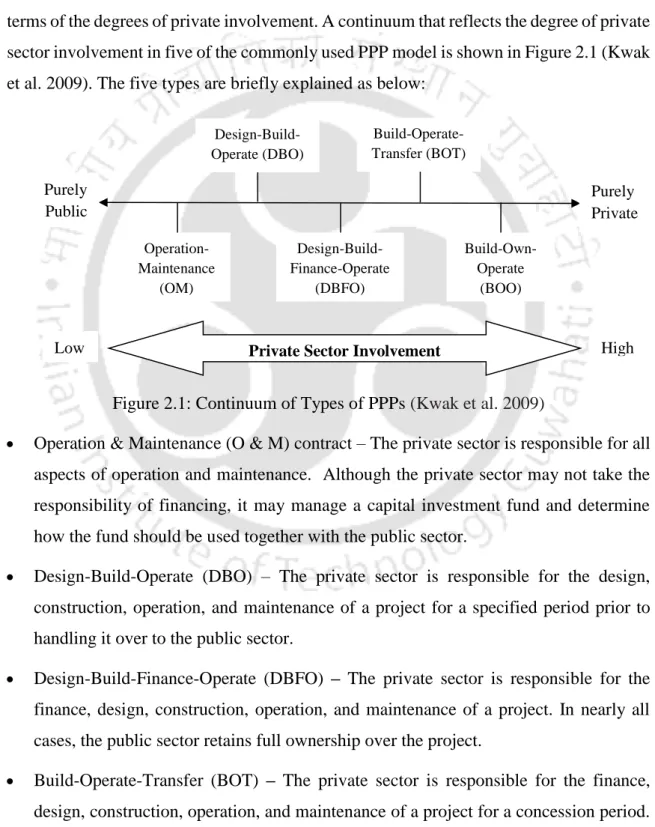
Sustainable Development and Sustainability
- Defining sustainability and sustainable development
- Evolution of sustainable development concept
- Assessment of sustainability: Approaches and framework
- Principles of sustainable development
Most of the frameworks developed for sustainability assessment of infrastructure development projects are based on the triple bottom line approach. The principles of the Rio Declaration are widely recognized as the foundation of global sustainability.
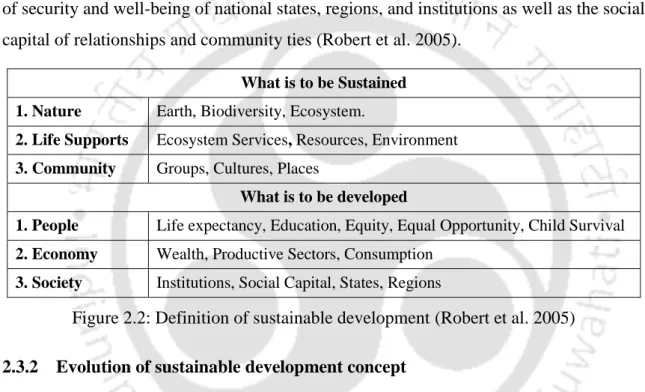
PPPs and Sustainable Development
Criticism on PPPs: Perspective of sustainability
CIPS (2008) pointed out that public-private partnerships have little incentive for the private sector to promote innovative and sustainable solutions to reduce environmental and social issues through the use of energy-efficient systems in the construction and operation of project facilities. UNHABITAT (2011) also made a similar observation that most public-private partnerships in the urban sector do not incorporate key principles of sustainable development into the planning and implementation process.
Integration of sustainability in PPP process
Some studies argue for the need to include the social and environmental dimension of sustainability in the PPP process. For example, Samuel and Oshani (2011) have pointed out some of the weaknesses of the PPP procurement process from a sustainability perspective by analyzing six different types of infrastructure projects.
Summary
PWC (2008) noted that the public and private sectors should consider a holistic approach to incorporating sustainability principles into project design, both at the planning and delivery stages. Finally, the experts who participated in the Policy Consultation Form (UNESCAP 2007) and the Expert Group Meeting (UNESCAP 2009) organized by the United Nations Economic and Social Commission for Asia and the Pacific (UNESCAP) also recognized the need introduced to the principles of sustainability in the PPP procurement process for the infrastructure development.
Introduction
Research Methodology and Method
Research Methods Used in the Study
Grounded theory
Grounded theory, an inductive research approach in the field of social science, was initially presented by Glaser and Strauss (1967) in 'The Discovery of Grounded Theory'. Data analysis (interpreting and organizing data) – The qualitative data from both sources (literature and interviews) were analyzed using the five steps of qualitative data analysis described by Miles et al.
Qualitative system dynamics modeling using CLDs
For the analysis of the interview data in the study, component and taxonomic analyzes were used. Theory development (theorizing/discussion) – The results from the data analysis step were then validated with the findings of the literature review through memo writing to develop the final framework. 2010) suggested that concepts and categories can best be explored to develop theory through conceptual memo writing.
Research Methodology Used in the Study
- Analysis of PPP procurement process from sustainability perspective
- Development of preliminary framework
- Development of final framework using grounded theory approach
- Assessment of causal behavior of framework
- Validation of framework
Preliminary model – The preliminary system dynamics model was then developed based on the conceptual model highlighting the various sustainability issues associated with the deliverables of the PPP procurement process. Modified model – The different strategies obtained from literature review and interviews were then integrated into the preliminary model depicting how the sustainability of PPP procurement process can be improved.
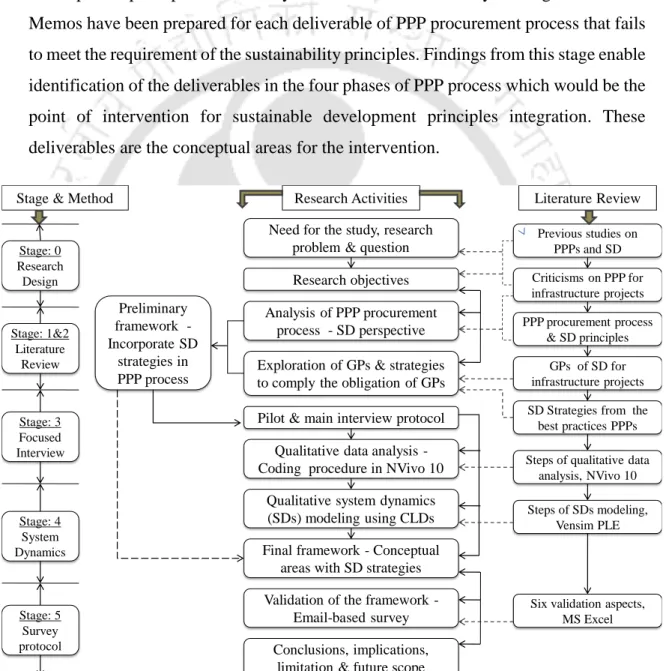
Qualitative Data Analysis Software
Qualitative Data Analysis Steps Used in the Study
- Importing and classification of the documents
- Data condensation: Coding
- Displaying the data
- Drawing and verifying of conclusions
- Developing a theory
The five steps of QDA have included two steps for 'displaying data' from Miles et al. Interpretation of the data for the development of grounded theory is the last step in the qualitative data analysis after completion of coding and analysis of qualitative data.
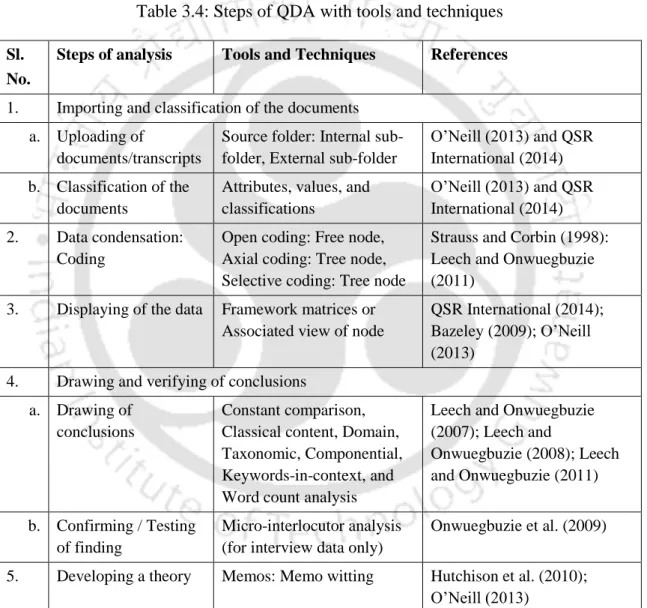
Summary
Further, the inductive grounded theory has been developed from interview data and confirmed with literature review data through writing final notes in NVivo. Computer-aided qualitative data analysis software package NVivo10 has been chosen for qualitative data analysis of literature and interview data.
Introduction
Data Collection and Analysis
In the first cycle of coding, each document was reviewed to identify the gaps in PPPs and these gaps were coded through open coding as a free node in NVivo10. Lack of incentives for the private sector, 6. Inadequate bid preparation and evaluation, 7. High user charges for infrastructure services, 8. Inadequate risk allocation and mitigation, 9. High bidding and transaction costs, 10.
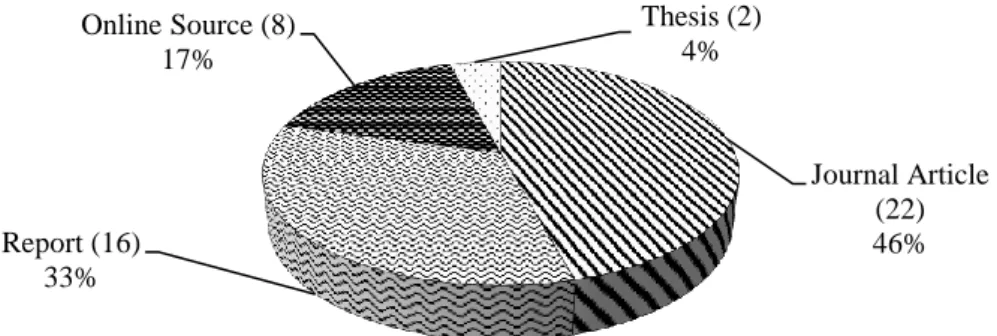
Results and Discussion
- Inefficient resource utilization & failure of socio-ecological integrity
- Intra-generational inequity and lack of livelihood sufficiency and
- Failure to promote socio-ecological civility & democratic governance
- Inadequate precautions and adoption measures
For example, there is little incentive for the private sector to use energy efficient systems in the construction and operation of the project facilities (CIPS 2008). However, one of the most common complaints by the general public against PPP projects is the high rates charged for the services provided by the private sector.
Summary
So there is a need to include sustainability principles in the conceptual areas/outcomes of the PPP procurement process so that it contributes to sustainable development. The next chapter/phase 2 of the research will focus on the possibility of integrating sustainability into the conceptual areas/outcomes of the PPP procurement process.
Introduction
Guiding Principles for Sustainability Assessment
Data collection and analysis
After identification of the guiding principles, classical content analysis and constant comparison analyzes were performed to count the number of articles coded under each guiding principle and classify the guiding principles according to the goals of the sustainability core principles that those guiding principles respectively meet. It has been determined through constant comparison analysis that all Guiding Principles have met the objectives of the Core Principles and Three Dimensions of Sustainability.
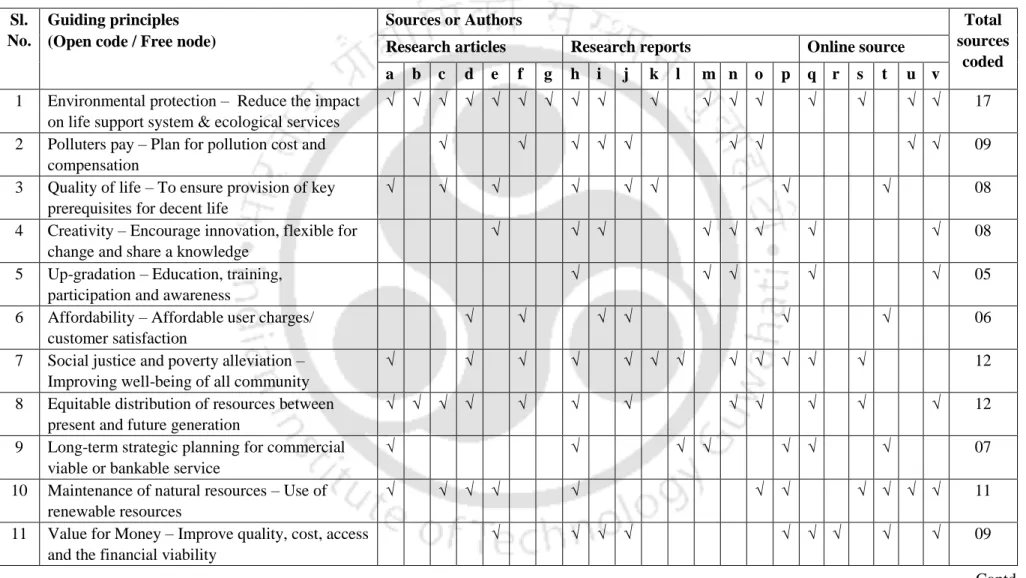
Guiding principles for sustainable infrastructure development
Equitable distribution of resources – One of the main objectives of sustainable development is to ensure that current and future generations enjoy an acceptable quality of life. The aim of risk allocation should be to optimally allocate project risks rather than to maximize risk transfer to the private sector.
Strategies on Best Sustainability Practices for PPPs
These strategies were then classified according to the objective of the guiding principles being fulfilled by those strategies. Each strategy was then described how to meet the objective of the corresponding sustainability principle through memo writing.
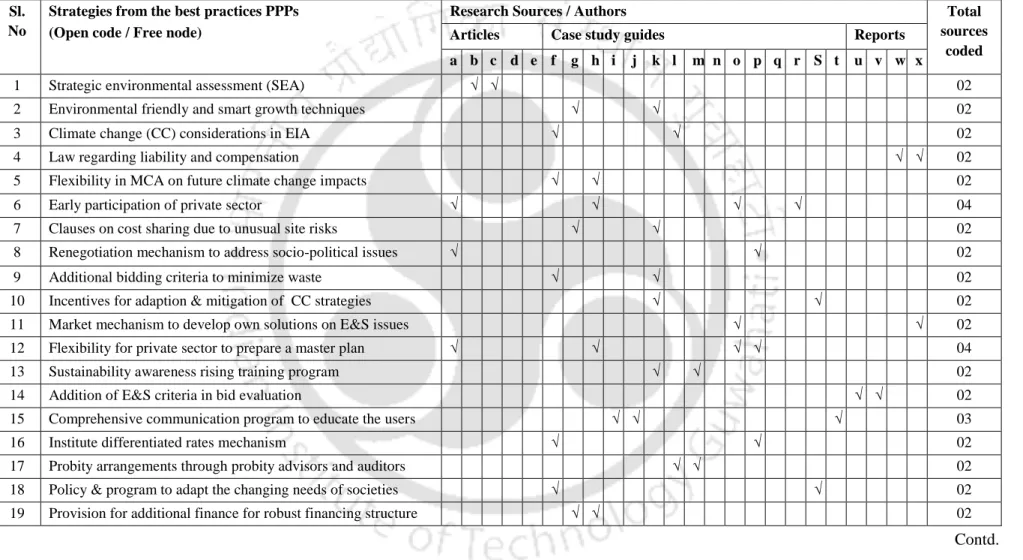
Development of Preliminary Framework
Discussion on preliminary framework
The inclusion of these three strategies (ST9, ST10 and ST11) will improve the bid evaluation process and help promote the sustainability of PPP projects by meeting the requirements of "maintenance and efficiency of resources" and "integrity of the socio- ecological". The lack of sustainability skills and knowledge can become a major obstacle to meeting the demand of socio-ecological civilization and the goals of sustainable democratic governance.
Summary
Including these strategies (ST21 to ST24) will help improve the risk allocation and mitigation mechanism in MCA from the perspective of the sustainable development principle of 'precaution and adaptation'. It has been observed that these strategies will help achieve the sustainability objective of at least one guiding principle.
Introduction
Method and Components of the Framework
Focused Interviews
Data Collection
From Figure 6.1 it can be observed that five out of six respondents have a postgraduate degree (ie higher qualification). Suggestions from the pilot study were incorporated into the final interview template that was used for the final interviews (main study) with 18 experts from the rest of the country.
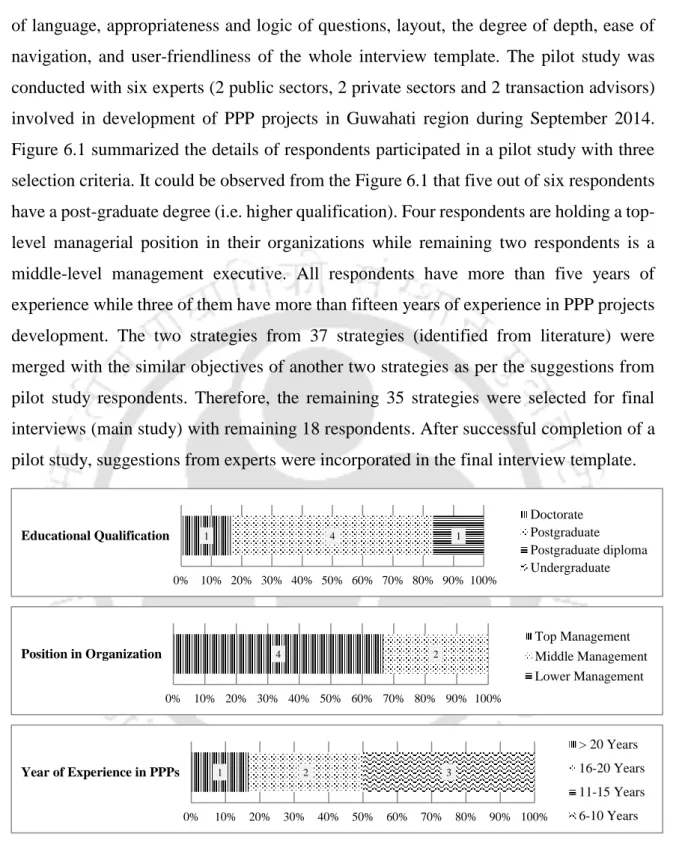
Data Analysis
The result of the matrix question for guiding principles to code different respondents is shown in Figure 6.3. From the classical content analysis, it was observed that the maximum number of coded respondents against any of the absences and strategies was 15.
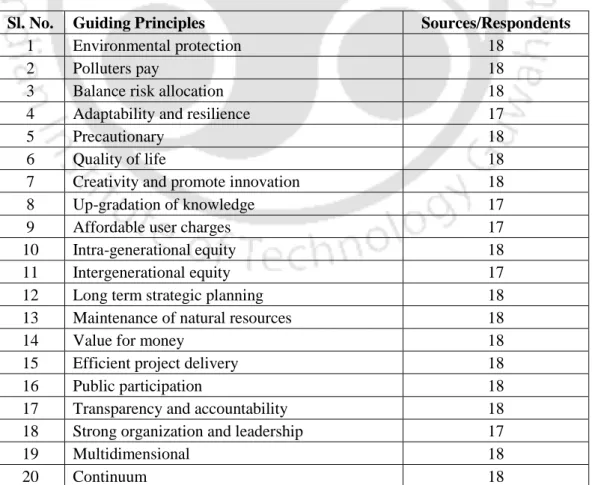
Discussion on the Final Framework
- Environmental and social impact assessment
- Stakeholders’ participation
- Value for money (VfM) analysis
- Skill and knowledge of sustainability concepts
- Incentives for private sector to promote sustainability
- Bid preparation and evaluation
- User charges for infrastructure services
- Risk allocation and mitigation in model concession agreement
- Bidding and transaction cost
- Transparency and accountability during bidding
- Relationship between public and private sector
In the current PPP procurement process, EIA is part of the feasibility study to minimize the impact of the project on the surrounding environment and society. The majority of public and private sector experts expressed reservations about the current risk allocation framework as it did not take into account the risks of future unforeseen impacts on the projects.
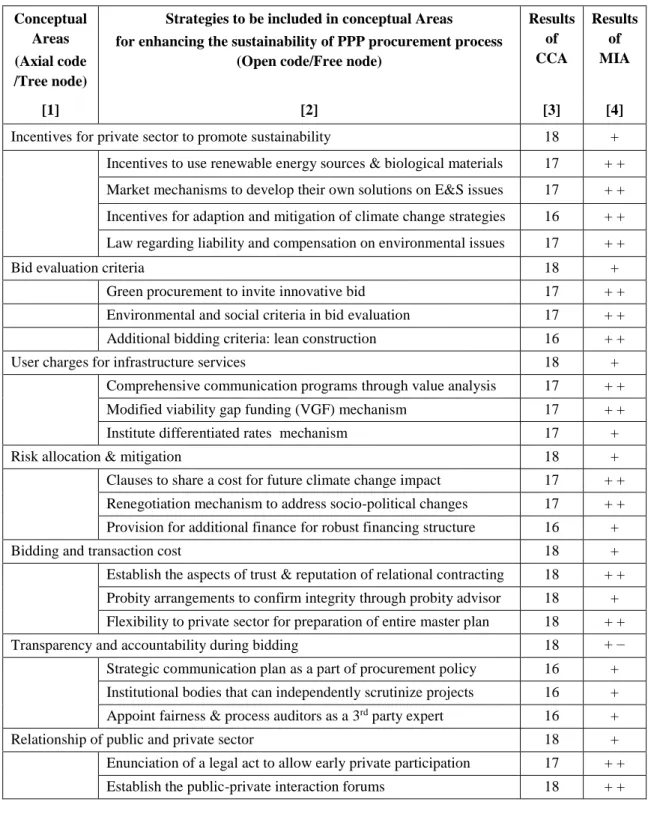
Summary
The final framework that emerged from the study identifies the need to strengthen public-private procurement according to eleven categories of conceptual areas. The final framework also includes strategies for improving the procurement process according to eleven categories of conceptual areas.
Introduction
Qualitative System Dynamics using CLDs
Preliminary model – Second, a preliminary system dynamics model is developed to identify various sustainability issues according to the relevant outcomes of the PPP process using the findings of the literature review. Findings from the literature review (phases 1 and 2) and focused interviews (phase 3) were used to develop the modified system dynamics model.
Conceptual Model of PPP Development
Conceptual Model - Initially, a conceptual system dynamics model was developed to recognize the key/important deliverables in the current Indian PPP procurement process through the literature review of government documents, reports and online database. Modified model – Finally, a modified system dynamics model was developed by including strategies to improve the sustainability of various deliverables in PPP procurement process in the preliminary system dynamics model.
Preliminary Model: Sustainability Issues in PPP Process
Therefore, the negative impact of the EIA is presented as a negative or balancing feedback loop (B1) in the preliminary model. This assessment does not consider environmental and social (E&S) aspects and this negatively hinders the fulfillment of the prerequisites of the sustainability principle of 'integrity of the socio-ecological system'.
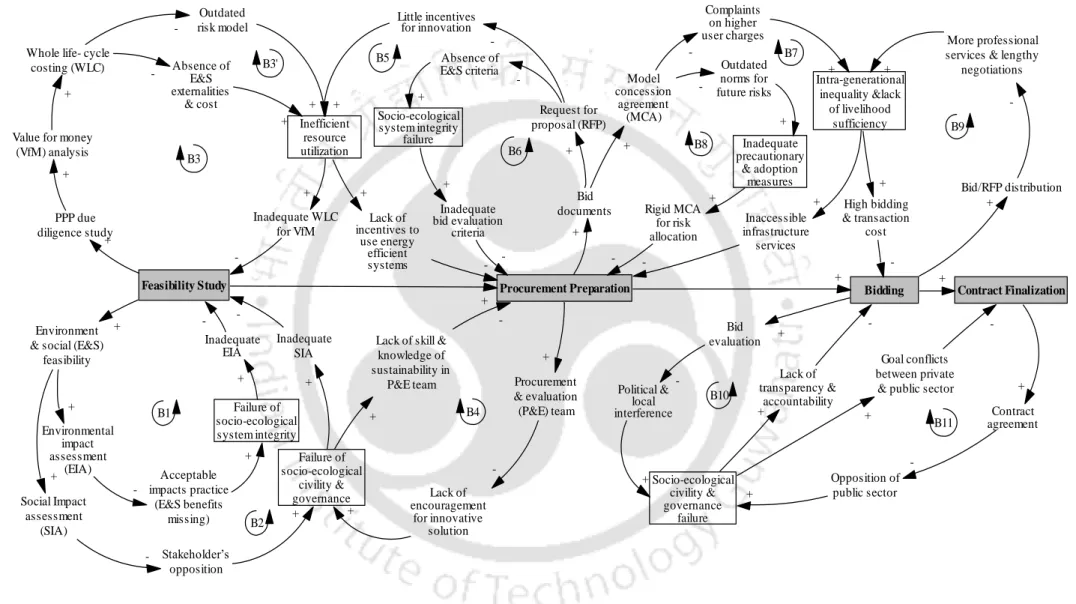
Modified Model: Inclusion of Strategies for Enhancement
Feasibility study
The positive impact of the inclusion of these two strategies in the system dynamics model has been shown as reinforced feedback loops R1b and R1c in Figure 7.3. The positive effect of inclusion of these two strategies has been shown in the modified model using the positive/reinforced feedback loops R2b and R2c, respectively.
Procurement preparation
The third strategy has been to introduce incentives for adaptation and mitigation of the impact of climate change on the project. The involvement of these three strategies has been shown using the positive reinforcement feedback loops R8a, R8b and R8c in Figure 7.4.
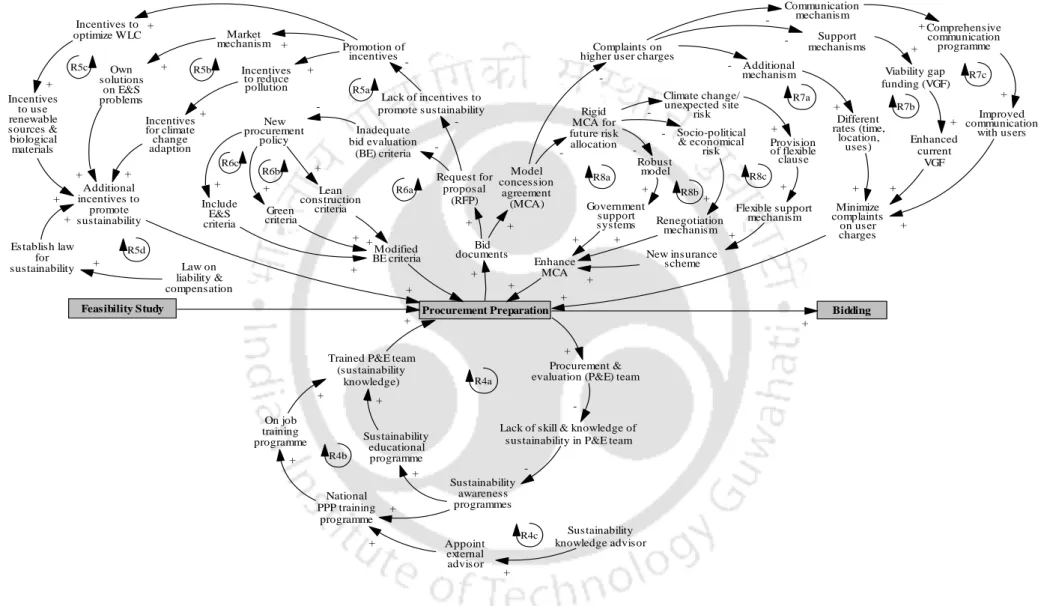
Bidding process and contract finalization
The second strategy is to promote early participation of the private sector in the identification phase of the PPP. Early participation of the private sector would play an important role in minimizing goal conflicts between public and private entities.
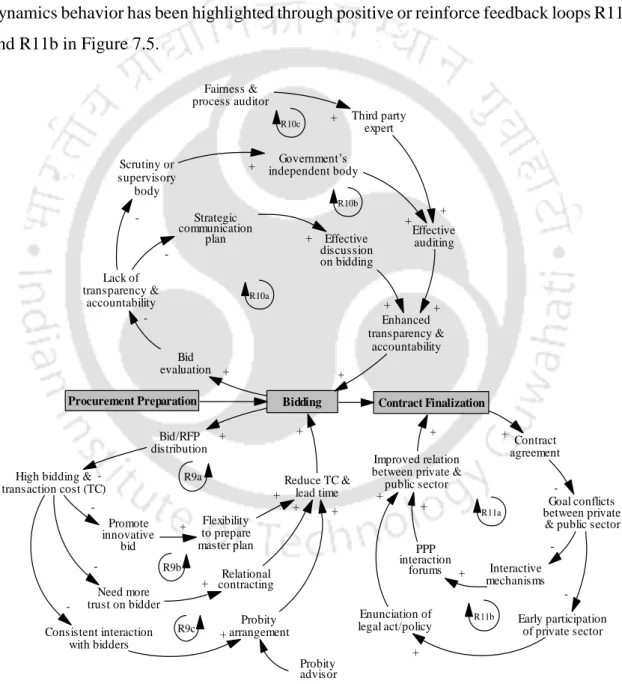
Summary
Introduction
Research Method for Validation
Degree of objectivity – Assess whether the framework has considered all the issues (shortcomings) in each phase of PPP procurement process from the perspective of sustainability. Degree of replicability – Assess whether the framework reflected all the respondents' views on the inclusion of each strategy in associated processes/activities of PPP procurement process.
Survey Protocol
Overall Reliability – Assess whether the overall framework, developed through the inclusion of various strategies in the associated processes/activities, will maintain the holistic triple bottom line balance of sustainability through the identification, development, procurement and management phases of the PPP procurement process. Overall Suitability for PPPs in India – Assess whether the framework, developed through the inclusion of various strategies in associated processes/activities, would be appropriate for PPP procurement practices for infrastructure development in India.
Results of Validation
Summary
Summary of the study
Major findings
To make the principles of sustainability meaningful and expressive, the study has introduced the concept of guiding principles through empirical analysis to guide specific decisions to achieve sustainability of infrastructure projects. To address this argument, a framework for integrating the principle of sustainability/guiding principles into respective deliverables or conceptual areas of the PPP procurement process has been developed.
Research implications
Limitations of the Current Study
Scope of the Future Research
34;Evaluation model for assessing suitability of public-private partnership projects." Journal of Management in Engineering. 34;Research Trend of Public-Private Partnership in Construction Magazines." Magazine for construction engineering and management.
Focused Interview Template
Respondents Participated in Focused Interview
Survey Template
Publications from this Thesis
